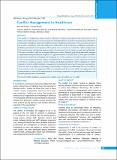Please use this identifier to cite or link to this item:
https://hdl.handle.net/20.500.14356/1499Full metadata record
| DC Field | Value | Language |
|---|---|---|
| dc.contributor.author | Piryani, Rano Mal | - |
| dc.contributor.author | Piryani, Suneel | - |
| dc.date.accessioned | 2023-05-14T09:46:04Z | - |
| dc.date.available | 2023-05-14T09:46:04Z | - |
| dc.date.issued | 2018 | - |
| dc.identifier.citation | PiryaniR. M., & PiryaniS. (2019). Conflict Management in Healthcare. Journal of Nepal Health Research Council, 16(41), 481-482. https://doi.org/10.33314/jnhrc.v16i41.1703 | en_US |
| dc.identifier.issn | Print ISSN: 1727-5482; Online ISSN: 1999-6217 | - |
| dc.identifier.uri | http://103.69.126.140:8080/handle/20.500.14356/1499 | - |
| dc.description | Short Communication | en_US |
| dc.description.abstract | Abstract The conflict is a disagreement within oneself or differences or dispute among persons that has potential to cause harm. It is inevitable and may occur in any profession including healthcare. It could be among any group of healthcare professionals or healthcare team between different group of healthcare professionals or between patient and any of the member of healthcare team. The conflict has a critical effect on the competence, confidence, and morale of healthcare professionals. Consequently, it affects patient care too. To prevent or limit the conflict, emphasis must be focused on proper and impartial implementation of a professional code of conduct, ground rules and discipline. The sources of conflict could real or imagined differences in values, dissimilar goals among individuals, improper communication and personalization of generic or organizational issue. Generally, there are four types of conflicts, intrapersonal, interpersonal, intragroup and intergroup.The conflict usually goes through four phases, frustration of one or more parties involved in conflict, conceptualization or rationalization of cause, expression of behaviors and behaviors resulting in negative outcome. Thomas and Kilmann postulated a matrix explaining five distinct responses or styles to conflict resolution or management varying along the axis of assertiveness and cooperativeness. These five styles are avoiding, accommodating, compromising, competing and collaborating. The issue in conflict is not its existence, rather its management. When it is managed poorly, the outcome will be uncomplimentary with counterproductive results and if managed properly, it encourages competition, recognize legitimate differences and becomes powerful source of motivation. Keywords: Conflict, healthcare, management of conflict, source of conflict, type of conflict. | en_US |
| dc.language.iso | en | en_US |
| dc.publisher | Nepal Health Research Council | en_US |
| dc.relation.ispartofseries | Oct-Dec 2018;1703 | - |
| dc.subject | Conflict | en_US |
| dc.subject | Healthcare | en_US |
| dc.subject | Management of conflict | en_US |
| dc.subject | Source of conflict | en_US |
| dc.subject | Type of conflict | en_US |
| dc.title | Conflict Management in Healthcare | en_US |
| dc.type | Journal Article | en_US |
| local.journal.category | Short Communication | - |
| Appears in Collections: | Vol. 16 No. 4 Issue 41 Oct - Dec 2018 | |
Files in This Item:
| File | Description | Size | Format | |
|---|---|---|---|---|
| 1703-Manuscript-7882-3-10-20190221.pdf | Fulltext Article. | 173.12 kB | Adobe PDF |  View/Open |
Items in DSpace are protected by copyright, with all rights reserved, unless otherwise indicated.
